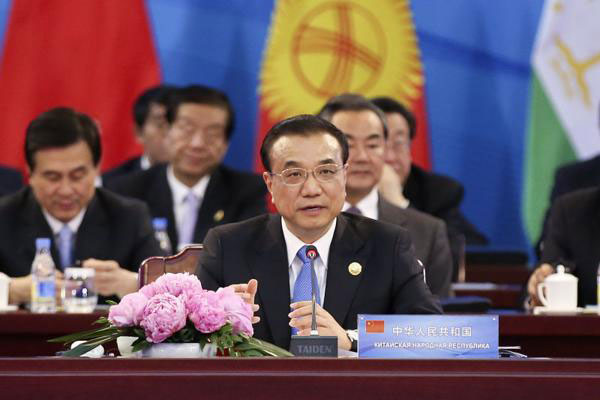Long-term policy reflects responsible leadership
Updated: 2016-02-23 07:48
By Dan Steinbock(China Daily)
|
||||||||
 |
|
Premier Li Keqiang speaks at the 14th Meeting of Prime Ministers of the Shanghai Cooperation Organization addresses the Shanghai Cooperation Organization (SCO), saying it should focus on building six cooperation platforms, in Zhengzhou, Henan province, on Dec 15. The platforms will cover six fields: security, production capacity, interconnectivity, innovative finance, regional trade and peoples' livelihoods. [Photo/Xinhua] |
Since spring 2014, Chinese President Xi Jinping has stressed that China must adapt to an economic new normal. In the short-term, that means slower growth, painful restructuring and conflicting responses following fiscal accommodation.
At the 2015 Central Economic Work Conference, the policy authorities pledged to focus increasingly on supply-side reforms, which prioritized the reduction of excess capacity while maintaining stability. That is likely to mean expanded fiscal spending and further monetary easing. As an effort to stimulate economic growth, the supply-side reforms represent the other side of the new normal.
In the foreseeable future, China will emulate neither the laissez-faire doctrines of the United States, which led to the global crisis, nor Europe's social accommodation, which is no longer supported by the region's growth.
In contrast, supply-side reforms seek to facilitate China's transition to a post-industrial society.
A hard landing describes a business cycle in which an economy slows down sharply or tips into recession after a rapid growth performance due to government efforts to rein in inflation. A hard landing can also be the unintended result of a central bank's efforts to tighten monetary policy to slow down growth and contain inflation.
Since the global financial crisis, many observers have argued that China is in the midst of such a hard landing. I have argued that they are wrong.
First, a hard landing is predicated on a central bank being willing to hike up rates to slow growth. In reality, the People's Bank of China has been cutting interest rates since early 2012.
Second, a hard landing indicates rising inflation. And yet, since late 2011 when inflation peaked at more than 6 percent, inflation in China has gradually decreased to less than 2 percent.
Third, a hard landing indicates a sharp slowdown in economic growth, if not outright recession. Yet, China's growth remains between 6.5 and 7 percent, more than four times as high as the eurozone's and almosecot three times higher than the US.
Finally, a hard landing is predicated on a business cycle. However, China's growth deceleration is fueled by the government's rebalancing efforts. The shift from unsustainable growth based on investment and net exports to consumption and innovation is about structural transformation, not just business cycles.
After the global financial crisis, China, thanks to its huge stimulus package, accounted for more than 50 percent of the global GDP growth from 2009 to 2010. It was an extraordinary contribution that spared the international economy from a 21st century replica of the 20th century's Global Depression. But in the future, the mainland will not be able to "bail out" global growth in a similar way.
At that time, China's GDP was less than 10 percent and its population about 20 percent of the total world population. Today, China accounts for about 25 percent of world GDP growth, which is closer to its share in the world economy. In the coming decade, China has the potential to grow two to three times faster than major advanced economies, as long as market-oriented structural reforms prevail.
Today, the US, Europe and Japan continue to take debt, have zero-bound interests or persist in new rounds of quantitative easing. In contrast, China's government is engaged in a structural transformation, even as it is deleveraging. After two to three years, that could result in a reform dividend.
That's a purposeful long-term policy, which reflects responsible economic leadership that should inspire the advanced West.
The author is the founder of Difference Group and has served as research director at the India, China and America Institute (US) and is visiting fellow at the Shanghai Institutes for International Studies (China) and the EU Centre (Singapore).
- Global health entering new era: WHO chief
- Brazil's planning minister steps aside after recordings revelation
- Vietnam, US adopt joint statement on advancing comprehensive partnership
- European border closures 'inhumane': UN refugee agency
- Japan's foreign minister calls A-bombings extremely regrettable
- Fukushima impact unprecedented for oceans: US expert

 Stars of Lijiang River: Elderly brothers with white beards
Stars of Lijiang River: Elderly brothers with white beards
 Wealthy Chinese children paying money to learn British manners
Wealthy Chinese children paying money to learn British manners
 Military-style wedding: Fighter jets, grooms in dashing uniforms
Military-style wedding: Fighter jets, grooms in dashing uniforms
 Striking photos around the world: May 16 - May 22
Striking photos around the world: May 16 - May 22
 Robots help elderly in nursing home in east China
Robots help elderly in nursing home in east China
 Hanging in the air: Chongqing holds rescue drill
Hanging in the air: Chongqing holds rescue drill
 2.1-ton tofu finishes in two hours in central China
2.1-ton tofu finishes in two hours in central China
 Six things you may not know about Grain Buds
Six things you may not know about Grain Buds
Most Viewed
Editor's Picks

|

|

|

|

|

|
Today's Top News
Liang avoids jail in shooting death
China's finance minister addresses ratings downgrade
Duke alumni visit Chinese Embassy
Marriott unlikely to top Anbang offer for Starwood: Observers
Chinese biopharma debuts on Nasdaq
What ends Jeb Bush's White House hopes
Investigation for Nicolas's campaign
Will US-ASEAN meeting be good for region?
US Weekly

|

|








